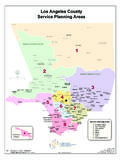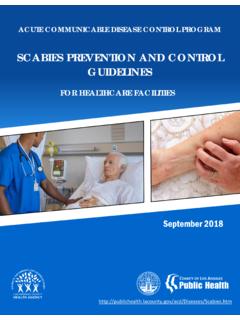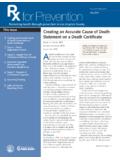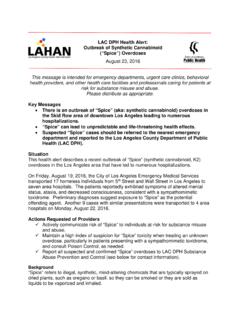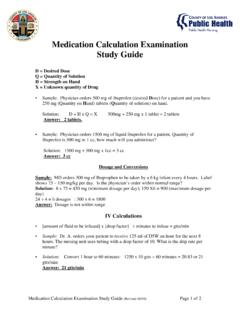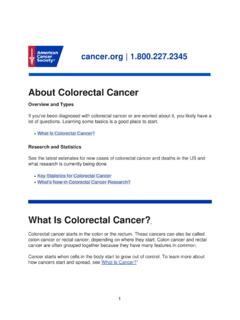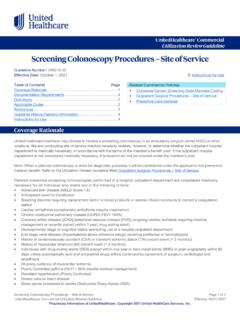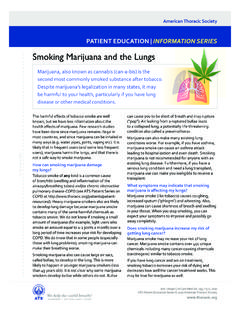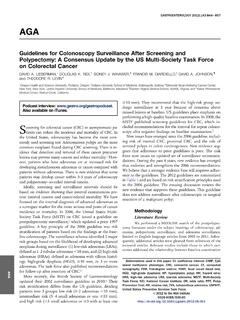Transcription of What are Neoplasia, Tumors and Cancer?
1 What are Neoplasia, Tumors and cancer ? Neoplasia (nee-oh-PLAY-zhuh) is the uncontrolled, abnormalgrowth of cells or tissues in the body, and the abnormal growth itselfis called a neoplasm (nee-oh-PLAZ-m) or tumor. It can be benign(bee-NINE) or malignant. Benign neoplasms do not grow aggressively,do not invade the surrounding body tissues, and do not spreadthroughout the body. Malignant neoplasms, on the other hand, tendto grow rapidly, invade the tissues around them, and spread, ormetastasize (me-TAS-ta-size), to other parts of the body. The word tumor or mass is often used to describe the actualswelling or other physical appearance of a neoplasm. The word cancer is often confused with neoplasia, but only malignantneoplasms are truly Common are Neoplasia and cancer ? Neoplasia is common in pet animals and the incidence increaseswith age.
2 cancer accounts for almost half of the deaths of pets over10 years of age. Dogs get cancer at roughly the same rate as humans,while cats get fewer is it Diagnosed?Is Neoplasia Preventable? Unfortunately, the cause of most neoplastic diseases is not knownand, therefore, prevention is difficult. Early detection andtreatment are the best ways to manage neoplasia in Types of Neoplasia in PetsSkin - Skin neoplasia is very common in older dogs, but much lesscommon in cats. Most skin neoplasms in cats are malignant, but indogs they are often benign. Your veterinarian should examine allskin neoplasms in a dog or cat to determine if any are Gland (Breast) - 50% of all breast neoplasms in dogsand greater than 85% of all breast neoplasms in cats are your female pet before 12 months of age will greatly reducethe risk of mammary gland & Neck - Neoplasia of the mouth is common in dogs and lesscommon in cats.
3 Signs to watch for are a mass or tumor on thegums, bleeding, odor, or difficulty eating. Since many swellings areHow is cancer Treated?malignant, early, aggressive treatment is essential. Neoplasia mayalso develop inside the nose of both cats and dogs. Bleeding fromthe nose, breathing difficulty, or facial swelling are signs that mayindicate neoplasia and should be checked by your - Lymphoma is a common form of neoplasia in dogs andcats. It is characterized by enlargement of one or many lymph nodesin the body. A contagious feline leukemia virus can be the cause oflymphoma in some - Testicular neoplasia is rare in cats and common in dogs,especially those with retained testicles (testicles that did not moveto their normal positions during growth, and may be located inthe abdomen or between the abdomen and scrotum).
4 Abdominal Neoplasia - Neoplasms inside the abdomen are commonbut it is difficult to make an early diagnosis. Weight loss or abdominalswelling can be signs of abdominal - Bone neoplasms are most often seen in large breed dogs anddogs older than seven years, and rarely in cats. The leg bones, nearjoints, are the most common sites. Persistent pain, lameness, andswelling in the affected area are common signs of the disease. Many of the above signs are also seen with non-neoplastic conditionsbut they still need prompt attention by a veterinarian to determinethe cause. Neoplasia is frequently treatable and early diagnosis willaid your veterinarian in delivering the best care possible. Neoplasia is often suspected onthe basis of the pet s medicalhistory and physical tests, such asradiographs (x-rays), blood tests,and ultrasound exams, may benecessary to confirm neoplasia.
5 Abiopsy (BYE-op-see), taking a tissuesample from the neoplasm for examination under a microscope,is usually necessary to confirm the diagnosis and help determineif the neoplasm is benign or malignant. Additional biopsies of othertissues, such as lymph nodes, may be necessary to determine howfar a malignant neoplasm ( cancer ) has spread. Each type of neoplasia requiresindividual care and may include one ora combination of treatment therapiessuch as surgery, chemotherapy, radiation,cryosurgery (freezing), hyperthermia(heating) or immunotherapy. Your pet soverall health is important too, and yourveterinarian may recommend dietarychanges or other things to help your petbetter respond to treatment. Once youhave a diagnosis, your veterinarian willdiscuss the best treatment option(s) foryour pet and the risks and side effectsassociated with each option.
6 Pain management is also an importantpart of treatment. In some instances, your veterinarian may referyou to a board-certified oncologist ( cancer specialist) and/or specialtyclinic depending upon the recommended course of treatment. Some types of neoplasia can be cured, but other types can only bemanaged to decrease spread and prolong your pet s comfort and lifeas much as possible. How early a neoplasm is detected and the typeof neoplasm are often the biggest factors determining the success oftreatment. Sometimes, euthanasia is considered when a pet has neoplasia(especially with some cancers). Before you make your decision fortreatment or euthanasia, discuss the options with your veterinarianso you can make the best choice for your pet and your Veterinary Medical Association1931 North Meacham Road, Suite 100 Schaumburg, Illinois 60173 - 4360 Phone: 847-925-8070 Fax: 10/08 Printed in the Resources for More Information american Veterinary Medical College of Veterinary Internal cancer Abnormal swellings that persist or continue to grow2.
7 Sores that do not heal3. Weight loss4. Loss of appetite5. Bleeding or discharge from any body opening6. Offensive odor7. Difficulty eating or swallowing8. Hesitation to exercise or loss of stamina9. Persistent lameness or stiffness10. Difficulty breathing, urinating, or defecating10 Common Signs of Neoplasia in Small AnimalsWhat is the Success Rate? This strongly depends upon the type and extent of the Neoplasia, as well as the aggressiveness of therapy. Benign neoplasms areusually easier to treat, and treatment of any type of neoplasia ismore likely to be successful if the neoplasms are detected some neoplasms (especially the more aggressive cancers)cannot be cured, treatment can prolong your pet s life and improvetheir quality of Will the Future Bring? We are learning more about neoplasia through research andexperience.
8 Animals today have a better chance of being successfullytreated for neoplasia and cancer than they did before, and the morewe learn about it, the more pets lives we can improve and diagnostic methods can help detect neoplasia earlier andimprove your pet s chances, and new treatment methods are beingdeveloped to provide better success rates with less risk of side brochure was developed with assistancefrom the Veterinary cancer society .
